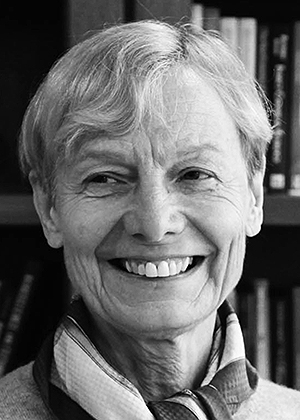Citation

With 4 decades of cutting-edge work in seismology, Barbara Romanowicz has transformed our understanding of the Earth’s mantle and core. She has made foundational contributions to geophysical infrastructure, and through the Cooperative Institute for Dynamic Earth Research (CIDER), she has brought together hundreds of early-career and senior scientists from across the geosciences to study Earth.
Dr. Romanowicz’s research is characterized by innovative seismological theory, sophisticated numerical methods, and insightful interpretations that have illuminated key Earth processes. Using tomography to image the distribution of seismic wave velocities, anisotropy, and attenuation, she has made groundbreaking connections between large-scale Earth structure and mantle convection. She demonstrated that the two large-scale low shear wave velocity regions at the base of the mantle consist of a bundle of thicker-than-expected hot upwelling plumes connected to major hot spots at the surface and showed that the roots of some of these plumes may contain partially molten material. She also made fundamental contributions to our understanding of the continental lithosphere and how it couples to the deeper mantle, showing that continental and oceanic lithospheres are both underlain by an asthenosphere that is highly anisotropic because of shear caused by plate motion and that the mantle lithosphere of ancient cratons contains two layers of anisotropy that relate to different stages of lithospheric formation. Dr. Romanowicz has been a leader in determining inner core structure, including attenuation and anisotropy and their implications for core formation and evolution. She has also contributed innovative studies of seismic wave sources, including earthquake statistics, scaling relationships, variations in rates of occurrence of great earthquakes, and the origins of the Earth’s “hum” (the continuous excitation of Earth’s free oscillations).
Dr. Romanowicz has given generously of her time to build lasting and open access infrastructure for the geoscience community. She led the development of Geoscope (1981–1990), the first global network of very broadband seismic stations. As the director of the Berkeley Seismological Laboratory (1991–2011) she initiated a real-time earthquake notification system in Northern California, expanding seismic and geodetic networks and data access. She is a key advocate and pioneer of long-term ocean bottom seismic stations.
Dr. Romanowicz was the visionary driving force behind CIDER for 15 years, each summer bringing together an interdisciplinary cohort of junior and senior scientists to engage in a month of lectures, tutorials, and research projects. CIDER has created a new generation of researchers who embrace cross-disciplinary study of Earth’s interior.
—Karen M. Fischer, Brown University, Providence, R.I.
Response
President Bell asked me to sit down before breaking the news to me—this was wise! This unexpected Bowie Medal is both an amazing and humbling honor. The only shadow is the fact that Louise Kellogg, who conominated me with Karen Fischer, is no longer with us. My warmest thanks to both of them, as well as to the other colleagues who supported my nomination.
I was fortunate to come to Institut de Physique du Globe in Paris to pursue a Ph.D. at the time when Claude Allègre was transforming it into a world-class institution. I have a connection with William Bowie: I started my research career in geodesy. High-precision measurements of Earth’s global gravity field were then becoming available owing to satellite geodesy. My Ph.D. advisor, Kurt Lambeck, suggested that I use these data to build a continental-scale model of the upper mantle beneath North America, but this quickly turned into a seismic travel time tomographic model, the first at that scale. My postdoc adviser at the Massachusetts Institute of Technology, Kei Aki, wanted me to work on earthquake prediction, but I chose to play with seismic surface waves instead. Looking back from my own experience as an adviser, I appreciate their open-mindedness and patience.
With the advent of very broadband seismic sensors and digital recording, the expansion of global and regional networks, open access to large-capacity data archives, increasing computer power, and concurrent theoretical developments, global seismic imaging has made tremendous progress in the past 40 years, but we are not done. A costly and technologically challenging task is to improve coverage of the ocean floor, key to further our understanding of the connections between deep mantle circulation and plate motions, and of Earth’s inner core evolution and, with it, of the geomagnetic field. We also need to continue educating ourselves and the successive younger generations across disciplines: Only by bringing together the different pieces of the puzzle can we gain a profound understanding of how Earth works. This is why we founded CIDER with Adam Dziewonski, Louise Kellogg, and Stan Hart. I wish to recognize their contributions, along with many other colleagues, to making it a successful endeavor.
My graduate students, postdocs, collaborators, and colleagues over the past 4 decades deserve to share this honor with me. I owe a big piece of this medal to my husband, Mark Jonikas, and children, Martin and Magda.
—Barbara Romanowicz, University of California, Berkeley; also at Collège de France, Paris
Citation:
(2020), Barbara Romanowicz receives 2019 William Bowie Medal, Eos, 101, https://doi.org/10.1029/2020EO138552. Published on 13 January 2020.
Text © 2020. AGU. CC BY-NC-ND 3.0
Except where otherwise noted, images are subject to copyright. Any reuse without express permission from the copyright owner is prohibited.
